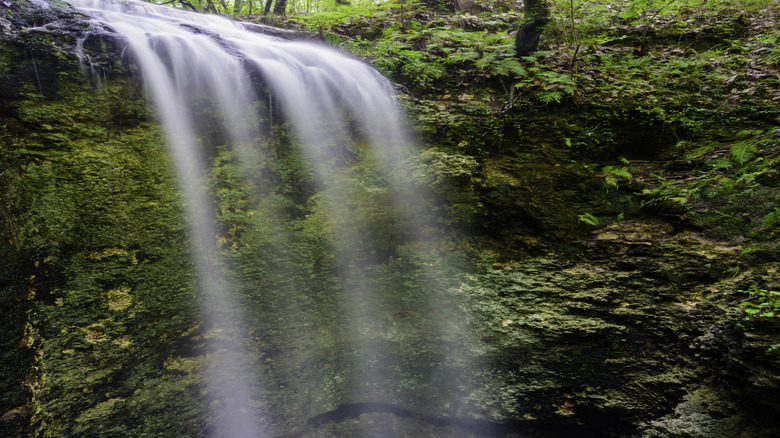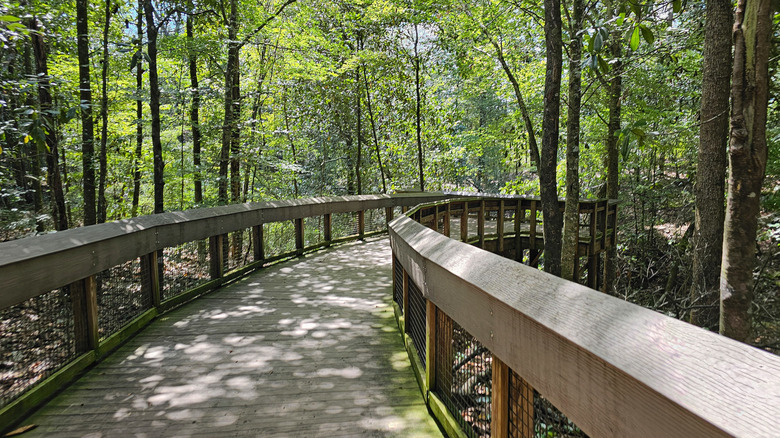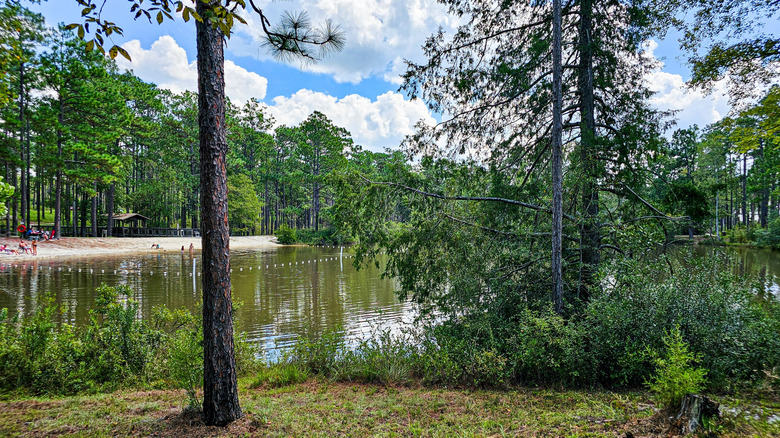
Picture this: you're traipsing along a planked boardwalk through swaths of lofty longleaf pines as blades of wiregrass sway in the breeze. You reach a massive clearing and step out onto an observation platform as a cool mist tickles your skin. Across the expanse, you can see rushing water cascading down rugged limestone rocks, seemingly falling into the depths of the earth as it disappears into a dark hole down below. No, you're not trekking across the likes of the Yucatán Peninsula or Amazon Rainforest.
You're in Florida, exploring Falling Waters State Park — home to the highest waterfall in the entire state.
"You feel like you have stepped into another world," one visitor shared on Tripadvisor about their experience at the idyllic state park. An apt sentiment because the otherworldly waterfall drops 73 feet into a sinkhole known as Falling Waters Sink. Spanning 20 feet in width, the cylindrical pit descends for 100 feet into a terrestrial cave system. And herein lies the waterfall's greatest mystery: no one knows where the water goes once it reaches these underground caverns. Curious indeed.
To get a peek at this wholly mystifying natural wonder, you'll want to venture south of the city of Chipley, tucked away in the northwest part of the Sunshine State. Perched midway between Pensacola and Tallahassee off Interstate 10, Falling Waters State Park is conveniently located near several major cities, including Panama City — where one of the nearest international airports is — so you shouldn't have any trouble getting there.
Read more: Secret US Beach Towns That Rival The Caribbean
Experience The Mystery Of Falling Waters

Falling Waters State Park opens bright and early at 8 a.m., closing at sunset throughout the year. At the time of writing, entry to the park costs $2 to $5, depending on the size of your group and whether or not you have a car. But consider it money well spent because this natural oasis is a real beaut.
The 173-acre park features several nature trails that wind around a series of other fern-covered sinkholes. The trail system only spans about 1 mile in total. But even though the paths are short, they can still be quite hilly, so be sure to wear sensible shoes. You can see the falls — a mix of rain and spring water — from two observation decks: the Upper Waterfall Overlook and the Lower Waterfall Overlook. Enjoy a nearly bird's-eye view of the waterfall from the former platform, while the latter takes you just below the sinkhole's rim for a chance to feel the mist as the water barrels down the rocks.
It's important to note that the waterfall's flow does vary greatly depending on the time of year. Since Falling Waters is largely fed by rainwater, visiting during the rainy season will increase the likelihood of seeing raging waters instead of a teensy trickle. For this reason, the Florida State Parks system recommends contacting Falling Waters ahead of your visit to ensure the waterfall is flowing strong. For more water fun, take a dip in the park's 2-acre freshwater lake, known as Turtle Lake, which even has a white sandy beach for lounging the afternoon away.
Tour Historic Sites, Go Birding, And Camp At Falling Waters

The mammoth waterfall is pretty spectacular, but it isn't the only gem of Falling Waters. Originally acquired in the early 1960s, the state park is teeming with fascinating history, too. Indigenous artifacts dating back to the Weeden Island archaeological time period of around 450 to 1,000 AD have been found on the grounds. You can also see the remnants of an old oil well shaft that was capped off in 1921.
For those keen to do a bit of wildlife watching, be sure to check out the on-site butterfly garden. The park could also be considered one of the best birdwatching destinations in America, home to more than 100 species of birds throughout the year, from red-headed woodpeckers to summer tanagers. While you hike, keep your eyes peeled for other native Florida Panhandle critters, such as foxes, deer, turtles, snakes, and lizards.
Want to stay longer? Grab your best camping gear for a comfortable night outdoors and reserve one of the two-dozen campsites at the Pine Ridge Campground. Despite standing a mere 324 feet above sea level, the campground still boasts the highest elevation in Florida, a state well-known for being flatter than a pancake. Once you've explored Falling Waters to your heart's content, set your sights on nearby hot spots like Torreya State Park, a scenic state park that visitors to Florida absolutely can't miss. Less than 40 minutes from Florida's tallest waterfall is the underrated and charming lake town of Defuniak Springs, known for its historic charm, quaint downtown, and lakeside scenery.
Ready to discover more hidden gems and expert travel tips? Subscribe to our free newsletter for access to the world's best-kept travel secrets.
Read the original article on Islands.











